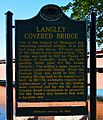Langley Covered Bridge facts for kids
Quick facts for kids Langley Covered Bridge |
|
|---|---|

Langley Covered Bridge—September 2016
|
|
| Coordinates | 41°58′02″N 085°31′41″W / 41.96722°N 85.52806°W |
| Carries | Covered Bridge Road |
| Crosses | St. Joseph River |
| Locale | Centreville, Michigan |
| Maintained by | St. Joseph County Road Commission |
| Characteristics | |
| Design | Howe truss |
| Total length | 282 ft (86 m) |
| Number of spans | 3 |
| Load limit | 3 short tons (2.7 t) |
| Clearance above | 7 ft (2.1 m) |
| History | |
| Construction end | 1887 |
| Designated: | August 31, 1965 |
The Langley Covered Bridge is the longest wooden covered bridge still standing in Michigan. You can find it about three miles north of Centreville. Centreville is the main town in St. Joseph County.
This special bridge crosses the St. Joseph River. It is part of Covered Bridge Road. The current bridge and the road leading to it first opened in 1887.
Contents
Bridge History
The Langley Covered Bridge was not the first bridge here. In 1887, a big flood on the St. Joseph River washed away an older bridge. This old bridge was about two blocks from where the current one stands.
The bridge we see today was built in 1887. A builder named Pierce Bodmer from nearby Parkville constructed it. Both Lockport and Nottawa Townships asked for the bridge to be built. It cost about $3,000 back then.
The bridge is named after Thomas W. Langley and his family. They were early settlers who helped start the village of Centreville in the mid-1800s. Thomas Langley was actually the very first person to settle in Centreville.
Keeping the Bridge Strong
In the 1940s, more and more cars started using the bridge. Their weight and vibrations began to damage the old wooden structure. People from all over Michigan and nearby states wanted the bridge to be saved.
The Elkhart Bridge and Iron Works company was hired to fix it. From 1950 to 1951, they worked on the bridge's underside. This big project cost $35,885. The bridge was closed from September 1950 to August 1951 for repairs.
During this time, the parts that carried the weight were changed. Wood was replaced with stronger steel or concrete. The old wooden floor was also replaced with new, treated wood planks.
Later, the bridge needed major repairs again. The St. Joseph County Road Commission hired Anlaan Corporation for this work. In 2008-2009, all the side panels were removed. The roof was replaced, and the asphalt on the road was taken off. The road surface was changed back to wood planks. This repair cost almost $1 million. During this project, two special frames were added. These frames have signs that warn tall vehicles not to enter.
Why Not a New Bridge?
In 1964, there was a discussion about the bridge. County road officials wanted to make the road wider between Centreville and Vicksburg. This would have meant replacing the historic covered bridge. However, the community decided to keep the old bridge instead.
Visiting the Bridge
Many covered bridges in Michigan and other states no longer exist. This makes the Langley Covered Bridge a very special historical place. For almost 130 years, it has been a beautiful spot for visitors.
Artists and photographers love to capture the bridge's changing shadows. History fans and bridge lovers come to see Michigan's longest covered bridge. Some people even enjoy fishing from inside the bridge!
Bridge Facts and Figures
The Langley Covered Bridge stretches 282 feet (86 m) across the river. It is made of three sections joined together. The bridge uses a special design called a Howe truss. This design helps the bridge hold a lot of weight.
The main parts of the bridge are made from White pine wood. The original sections are each 94-foot (29 m) long. Together, they make the total length of 282-foot (86 m). The bridge is 19 feet (5.8 m) wide and 16 feet (4.9 m) high.
The bridge's floor rests on 40 strong beams. Each beam is 8 inches (20 cm) by 12 inches (30 cm) and 19 feet (5.8 m) long. About 1,700 vehicles use the bridge every day. During the 2008–09 repairs, two height warning frames were added. These frames cost $20,000 each, totaling $40,000. They help protect the bridge from tall vehicles.
When the Sturgis Dam was built, the bridge had to be raised eight feet (two point four metres). This was done to keep it safe from rising water levels. From 1950 to 1951, the St. Joseph County Road Commission worked to save the bridge. They replaced old wooden foundations with wood reinforced by steel beams. This repair cost almost $36,000.
There are three main rules for using the bridge. Vehicles must weigh less than three-short-ton (two-point-seven-tonne). They must be shorter than seven-foot (2.1 m). Also, there is a limit on how wide vehicles can be. Many warning signs are placed before the bridge to remind drivers of these rules. Even with the signs, sometimes people hit the metal warnings. In 2016, a sign was damaged and had to be replaced.
Other Events
The Langley Covered Bridge has been an important symbol for Centreville for nearly 100 years. Since 1975, the village's yearly summer celebration is called "Covered Bridge Days." A local newspaper in the 1960s even used a drawing of the bridge as its logo.
The Three Rivers Chamber of Commerce once held a special event at the bridge. They closed the bridge for a charity dinner. This event was planned with the county road commission, who were already doing some work on the bridge's deck.
Photo gallery






